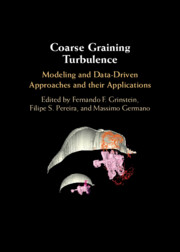Book contents
- Frontmatter
- Contents
- Contributors
- Prologue
- Part I Paradigms and Tools
- 1 Numerical Simulations and Coarse-Graining
- 2 An Overview of Scale-Resolving Simulation Models for Practical Flows
- 3 Filtering Approaches and Coarse Graining
- 4 Filtered Density Function
- 5 Symmetries, Subgrid-Scale Modeling, and Coarse Graining
- 6 Coarse-Graining Turbulence Using the Mori–Zwanzig Formalism
- 7 Data-Driven Modeling for Coarse Graining
- 8 Verification, Validation, Uncertainty Quantification, and Coarse-Graining
- Part II Challenges
- Epilogue
- Abbreviations
- Index
- References
7 - Data-Driven Modeling for Coarse Graining
from Part I - Paradigms and Tools
Published online by Cambridge University Press: 31 January 2025
- Frontmatter
- Contents
- Contributors
- Prologue
- Part I Paradigms and Tools
- 1 Numerical Simulations and Coarse-Graining
- 2 An Overview of Scale-Resolving Simulation Models for Practical Flows
- 3 Filtering Approaches and Coarse Graining
- 4 Filtered Density Function
- 5 Symmetries, Subgrid-Scale Modeling, and Coarse Graining
- 6 Coarse-Graining Turbulence Using the Mori–Zwanzig Formalism
- 7 Data-Driven Modeling for Coarse Graining
- 8 Verification, Validation, Uncertainty Quantification, and Coarse-Graining
- Part II Challenges
- Epilogue
- Abbreviations
- Index
- References
Summary
This chapter gives an overview of data-driven methods applied to turbulence closure modeling for coarse graining. A non-exhaustive introduction of the various data-driven approaches that have been used in the context of closure modeling is provided which includes a discussion of model consistency, which is the ultimate indicator of a successful model, and other key concepts. More details are then presented for two specific methods, one a neural-network representative of nontransparent black-box approaches and one specific type of evolutionary algorithm representative of transparent approaches yielding explicit mathematical expressions. The importance of satisfying physical constraints is emphasized and methods to choose the most relevant input features are suggested. Several recent applications of data-driven methods to subgrid closure modeling are discussed, both for nonreactive and reactive flow configurations. The chapter is concluded with current trends and an assessment of what can be realistically expected of data-driven methods for coarse graining.
- Type
- Chapter
- Information
- Coarse Graining TurbulenceModeling and Data-Driven Approaches and their Applications, pp. 202 - 221Publisher: Cambridge University PressPrint publication year: 2025

